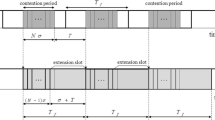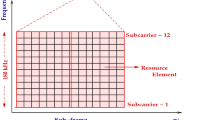Abstract
A bandwidth reservation multiple access scheme(BRMA) is proposed to resolve contention and assignbandwidth among multiple users trying to gain access toa common channel such as in mobile users contending for resources in an ATM-based cellular networkor a wireless local area network (LAN) with shortpropagation delays. The protocol is best suited tosupport variable-bit-rate (VBR) traffic that exhibits high temporal fluctuations. Each mobile user isconnected end-to-end to another user over virtualchannels via the base station that is connected to thewired ATM B-ISDN network. The channel capacity is modeled as a time frame with a fixed duration.Each frame starts with minislots, to resolve contentionand reserve bandwidth, followed by data-transmissionslots. Every contending user places a request for data slots in one of the minislots. If therequest is granted by the base station through adownlink broadcast channel, the user then startstransmission in the assigned slot(s). The number ofassigned slots varies according to the required qualityof service (QoS), such as delay and packet lossprobability. A speech activity detector is utilized inorder to indicate the talkspurts to avoid wastingbandwidth. Due to its asynchronous nature, BRMA is ratherinsensitive to the burstiness of the traffic. Since theassignment of the minislots is deterministic, therequest channels are contention-free and the data channels are collision-free. Hence, in spite ofthe overhead (minislots) in each frame, BRMA provideshigher throughput than Packet Reservation MultipleAccess (PRMA) for the same QoS, especially for high-speed systems. A better delay performance is alsoachieved for data traffic compared to Slotted Alohareservation-type protocol PRMA. In addition, BRMAperforms better in terms of bandwidth efficiency thanthe conventional TDMA or the Dynamic TDMA, wherespeech activity detectors are very difficult toimplement.
Similar content being viewed by others
REFERENCES
D. Petras, Performance evaluation of medium access control schemes for mobile broadband systems. In DMR VI, Stockholm, pp. 255–261, June 1994.
D. Petras, Medium access control protocol for transparent ATM access in MBS. In RACE Mobile Telecommunications Summit, Cascais, Portugal, November 1995.
D. Petras, Medium access control protocol for wireless, transparent ATM access. In IEEE Wireless Communication Systems Symposium, Long Island, New York, November 1996.
D. Petras, MAC protocol for wireless ATM: Contention free versus contention based transmission of reservation requests. In Proceedings of PIMRC’96, Taiwan, October, 1996.
J. Deane, WATM MAC requirements, WATM Forum Document 96-0786, June 1996.
M. Karol, Z. Liu, et al., An efficient demand-assignment MAC protocol for WATM networks, ACM WINET Journal, Vol. 1,No. 3, 1996.
D. Petras, A. Hettich, and A. Kramling, Performance evaluation of a logical link control protocol for an ATM air interface. In PIMRC’96, Taiwan, 1996.
L. Fernandes, Developing a system concept and technologies for mobile broadband communications, IEEE Personal Communications, Vol. 2, pp. 54–59, February 1995.
ETSI-RES10, High Performance Radio Local Area Network (HIPERLAN), Draft Standard, Sophia Antipolis, France, 1995.
J. E. Padgett, C. G. Gunther, and T. Hattori, Overview of wireless personal communications, IEEE Communications Magazine, Vol. 33,No. 1, pp. 38–41, 1995.
D. Raychaudhuri and N. D. Wilson, ATM-based transport architecture for multiservices wireless personal communication networks, IEEE Journal on Selected Areas in Communications, Vol. 12,No. 8, pp. 1401–1414, 1994.
R. Steele, The evolution of personal communications, IEEE Personal Communications, Vol. 1,No. 2, pp. 6–11, 1994.
T. Haug, Overview of GSM: Philosophy and results, International Journal of Wireless Information Networks, Vol. 1,No. 1, pp. 7–16, 1994.
D.D. Falconer, F. Adachi, and B. Gudmundson, Time division multiple access methods for wireless personal communications, IEEE Communications Magazine, Vol. 33,No. 1, pp. 50–57, 1995.
N. D. Wilson, R. Ganesh, K. Joseph, and D. Raychaudhuri, Packet CDMA versus dynamic TDMA for multiple access in an integrated voice/data PCN, IEEE Journal on Selected Areas in Communications, Vol. 11,No. 6, pp. 870–884, 1993.
D. J. Goodman, R. A. Valenzuela, K. T. Gayliard, and B. Ramamurthi, Packet reservation multiple access for local wireless communications, IEEE Transactions on Communications, Vol. 37,No. 8, pp. 885–889, 1989.
D. J. Goodman and S. X. Wei, Efficiency of packet reservation multiple access, IEEE Transactions on Vehicular Technology, Vol. 40,No. 1, pp. 170–176, 1991.
S. Nanda, Analysis of packet reservation multiple access: Voice and data integration for wireless networks. In Proceedings of GLOBECOM’90, San Diego, CA, pp. 1984–1988, 1990.
M. Frullone, G. Riva, P. Grizioso, and M. Missiroli, Comparisons of multiple access schemes for personal communication systems in a mixed cellular environment, IEEE Transactions on Vehicular Technology, Vol. 43,No. 1, pp. 99–109, 1994.
W.-C. Wong, Packet reservation multiple access in a metropolitan microcellular radio environment, IEEE Journal on Selected Areas in Communications, Vol. 6, pp. 918–925, 1993.
G. Wu, K. Mukumoto, and A. Fukuda, Analysis of an integrated voice and data transmission system using packet reservation multiple access. IEEE Transactions on Vehicular Technology, Vol. 43,No. 2, pp. 289–397, 1994.
N. M. Mitrou, Th. D. Orinos, and E. N. Protonotarios, A reservation multiple access protocol for microcellu lar mobile-communication systems, IEEE Transactions on Vehicular Technology, Vol. 39,No. 4, pp. 340–350, 1990.
K. Pahlavan, T. H. Prober, and M. E. Chase, Trends in local wireless networks, IEEE Communications Magazine, pp. 88–95, March 1995.
I. Habib and T. Saadawi, Dynamic bandwidth and access control of virtual paths in ATM Networks. In Proceeding of IFIP 3rd International Conference on High Speed Networks, Belgium, December 1992.
I. Habib and T. Saadawi, Dynamic bandwidth control in ATM networks, Journal of Computer Communications, accepted for publication.
R. Droms, Dynamic host configuration protocol, RFC 1541, October 1993.
M. de Prycker, Asynchronous Transfer Mode-Solution for Broadband ISDN, Alcatel Bell, Antwerp, Belgium, 1991.
A. S. Tanenbaum, Computer Networks, Prentice-Hall, Englewood Cliffs, NJ, 1996.
Q. Zhu, J. G. Kneuer, and W.-M. Huang, A study of temporal behavior between the packet loss bursts in packet switched systems. In IEEE Proceedings of International Conference on Communications, 1995.
S.-Q. Li, A general solution technique for discrete queueing analysis of multimedia traffic on ATM, IEEE Transactions on Communications, Vol. 39,No. 7, pp. 1115–1132, 1991.
M. Neuts, Matrix-Geometric Solutions in Stochastic Models, Johns Hopkins University Press, Baltimore, MD, 1981.
T. N. Saadawi, M. H. Ammar, and A. El Hakeem, Fundamentals of Telecommunication Networks, Wiley, New York, 1994.
J. E. Wieselthier and A. Ephremides, Fixed-and moveable-boundary channel-access schemes for integrated voice/data wireless networks, IEEE Transactions on Communications, Vol. 43,No. 1, pp. 64–74, 1995.
H. Heffes and D. M. Lucantoni, A Markov modulated characterization of packetized voice and data traffic and related statistical multiplexer performance, IEEE Journal on Selected Areas in Communications, Vol. SAC-4,No. 6, pp. 856–868, 1986.
A. Baiocchi, N.B. Melazzi, M. Listanti, A. Roveri, and R. Winkler, Loss performance analysis of an ATM multiplexer loaded with high-speed on-off sources, IEEE Journal on Selected Areas in Communications, Vol. 9,No. 3, pp. 388–393, 1991.
Rights and permissions
About this article
Cite this article
Zhang, Z., Habib, I. & Saadawi, T. A Bandwidth Reservation Multiple Access Protocol for Wireless ATM Local Networks. International Journal of Wireless Information Networks 4, 147–161 (1997). https://doi.org/10.1023/A:1018898009231
Issue Date:
DOI: https://doi.org/10.1023/A:1018898009231




